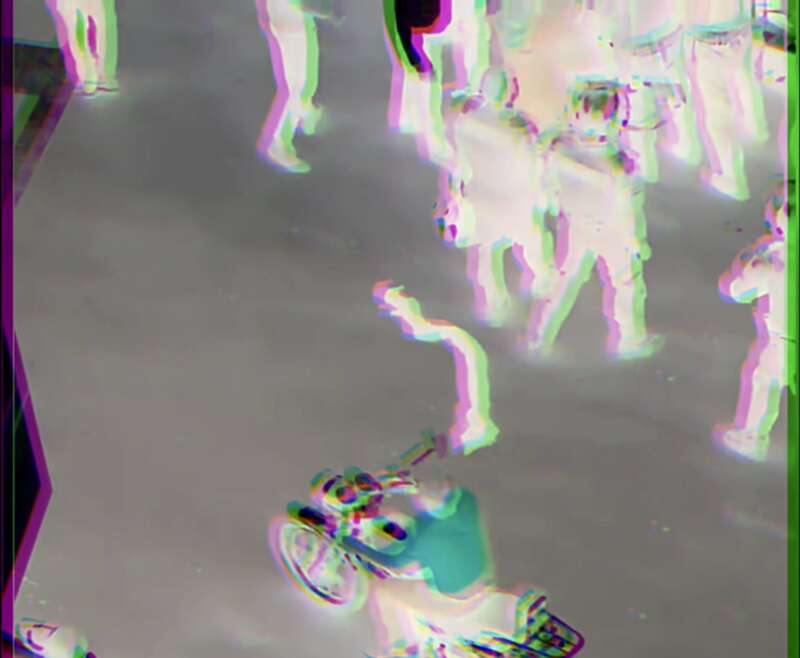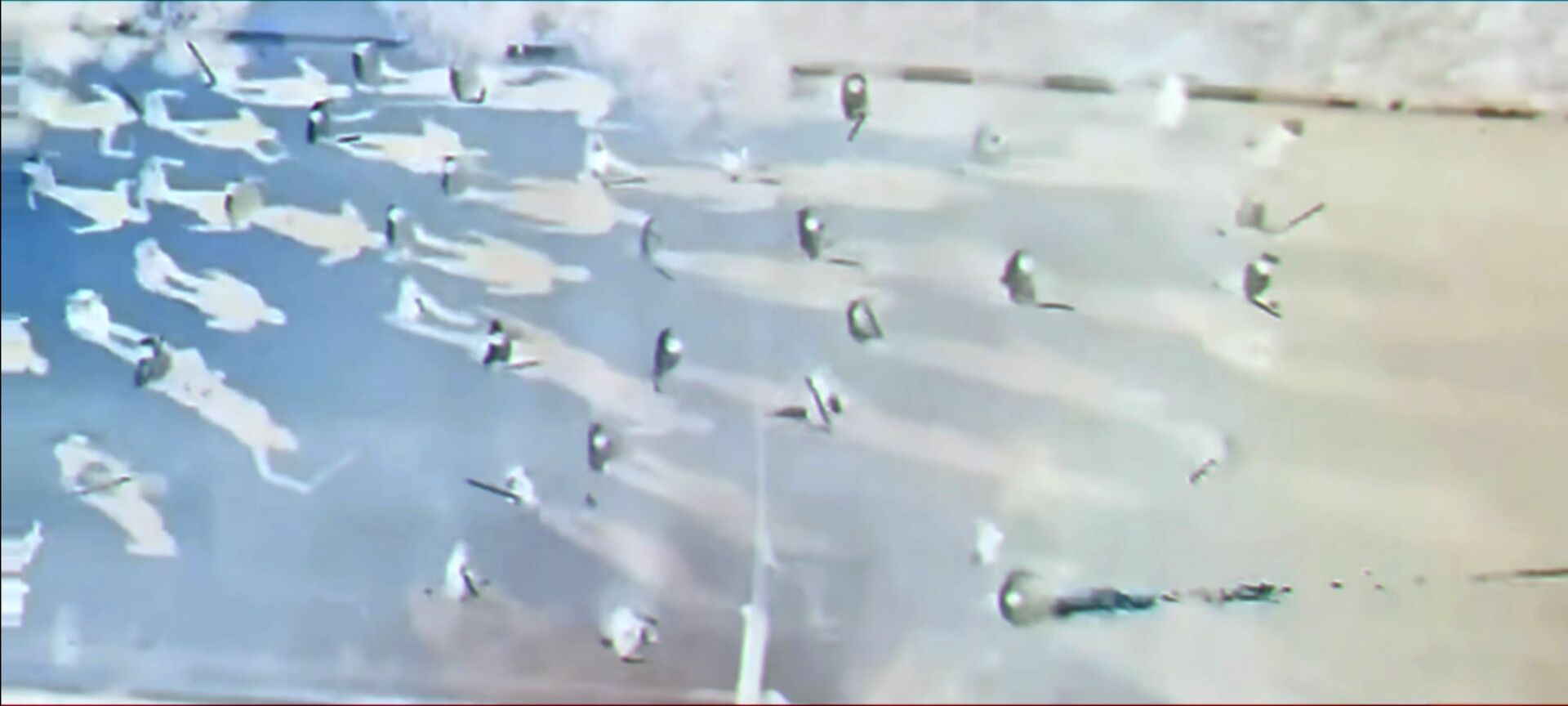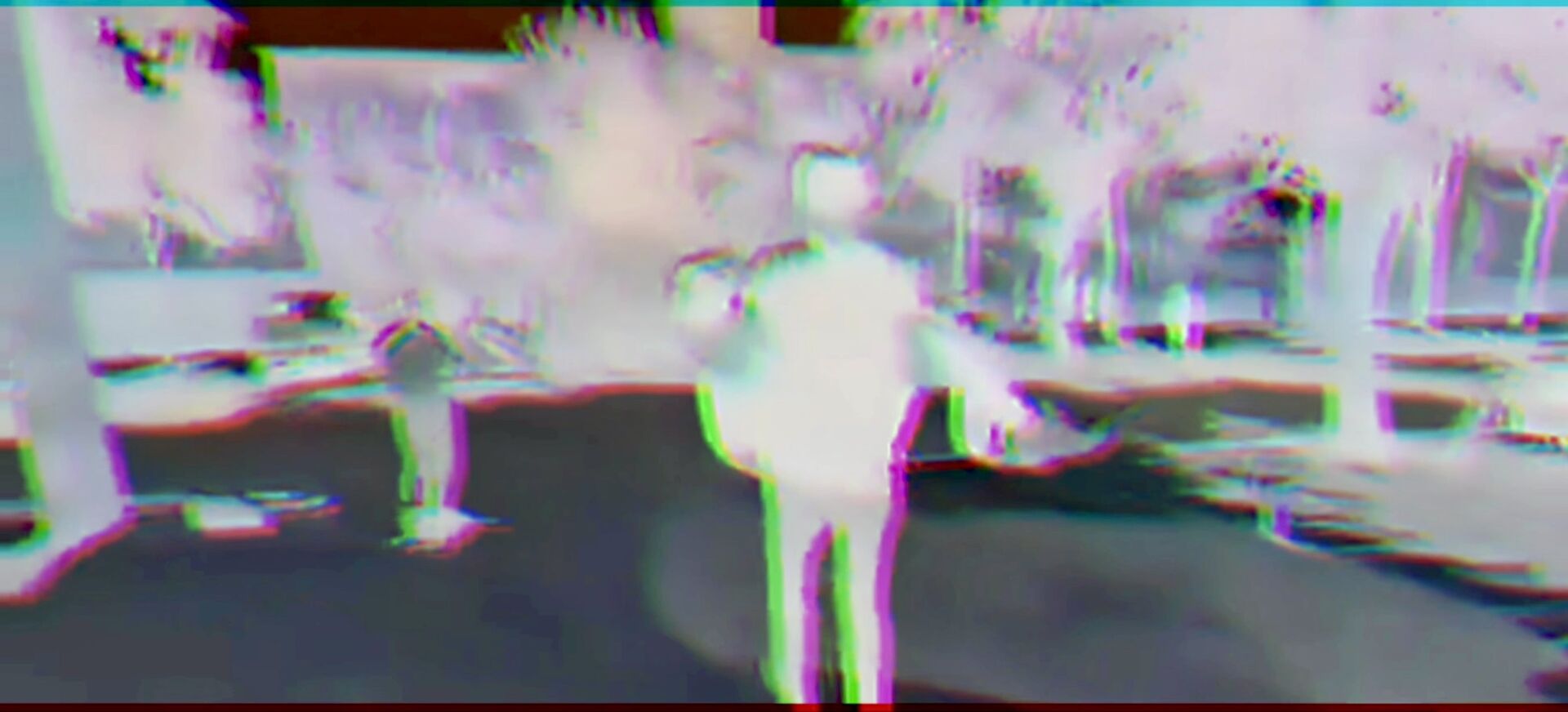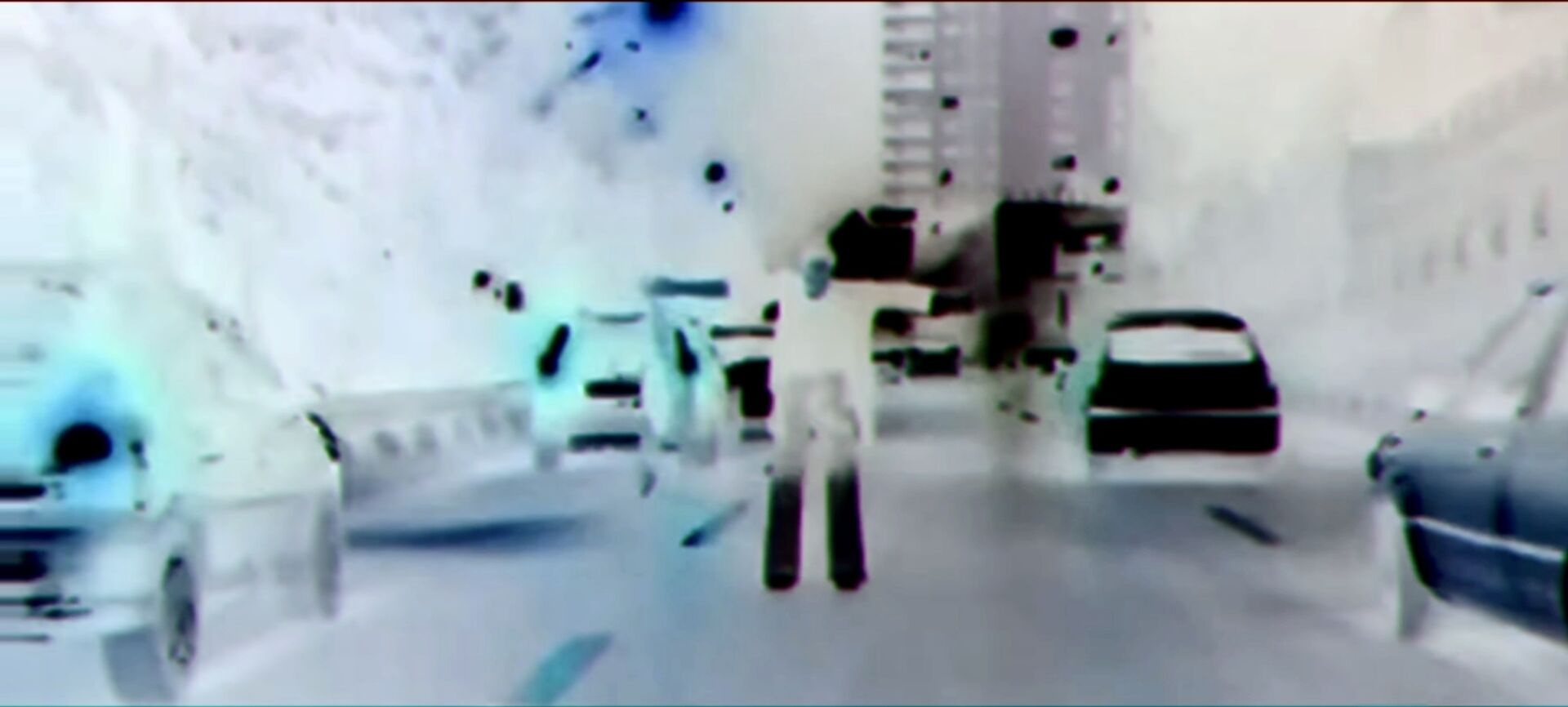
All images © Mona Hedayati
Glitching the Frame: Images and the Unsettling of Witnessing
Silent, colour-inverted figures with their interwoven shadows flash on the wall. Frenzied, uncanny, menacing, unearthly. Human bodies pull, push, entangle, detangle, unleash, slip, float, run, and freeze, somewhere, nowhere. A thrust and a fall. Glitch after glitch.
Mona Hedayati
17 feb. 2025 • 15 min
The lived experience of migration, for me, is far from a straightforward one that can be represented as a dramatic narration. It’s shot through with paradoxical discomforts that are hard to locate and make sense of and even harder to convey. Resonant Atmospheres: The Techno-Performance of Affection is an artistic project where I began to reckon with these hindrances in narration and issues of representation. I devised participatory audio-visual performances with the aim of making the intensity and tensions of my experience felt beyond the conventions of image-based and linguistic storytelling. The visual component of these performances consists of cellphone-shot videos taken by protestors in the streets of Iran. These video documentations depict the violent suppression of socio-political uprisings, the density of which has marked the recent history of the country. My distance from these events, as a migrant in exile, somehow made them all the more close to the skin. Watching them from afar hence brought significant distress and pain. Implicating these videos in an artistic project was a way for me to convey the complexities of migration against the simplistic image of ‘the pain of being away from home’.
In Resonant Atmospheres, I make use of a wearable device that measures fluctuations in biometric rhythms. More precisely, I singled out the pulse rate as an intimate metric that captures changes in the participant’s stress response. Creating what I call ‘data-responsive images’, the static footage responds to the pulse in real time by shifting the parameters of the moving image with every pulse. Each pulse thus amounts to a colour shift and distortion of the image. The original footage depicts gut-wrenching violence, assault, and violation – particularly against women, given the feminist nature of the recent round of uprising that became known as the 'Woman, Life, Freedom' movement. However, I selected and edited segments that don’t portray crude violence but preserve gestures and actions prior to or after these acts. In hinting at violence, these moments leave space for imagination and hence, in their nondisclosure, appear foreboding. This strategy, or rather counterstrategy, came in response to the drive to elicit empathy by representing the pain of others as images.
Resonant Atmospheres: The Techno-Performance of Affection
The footage I used, however, was anything but a normative representation of these events. My intention was to steer away from logical progression and cognitive sensemaking, messing with the act of recognition by troubling the coherence of the linear narrative. In essence, affective and precognitive response was what I was after. So, beyond tinkering with image qualities, I also moved away from my role as the performer performing my response to these events. Instead, I swapped the roles to have the audience-turned-participants respond to them. I wanted the anticipatory violence in the ambiguity of documentary footage to trigger an embodied response in the participants that also surfaces on the image. Imagining a dual responsiveness, making visible the invisible biorhythm induces a further layer of emotional response to maintain a loop between body and image. In this sense, it’s not only the image that is responding to the pulse but also the participant that is responding to the data-responsive image. But why participation to begin with? With participation, I wanted to bypass the classic storytelling strategy where the audience is on the receiving end of a straightforward story of the marginalized ‘other’. Instead of depicting direct representation of trauma, terror, and duress, I wanted to disengage with the familiar mechanism of eliciting and performing empathy.
While empathy is largely known as part of a constructive rhetoric that encourages building bonds and relating to one another, it has been problematised and resisted from the margins. In her influential book Scenes of Subjection, Saidiya Hartman discusses the role of witnessing as a means of engaging with Black suffering and trauma. She questions the ethical implications of observing such events and implicates the viewer as withholding responsibility. She throws into question this familiar mode of eliciting empathy: ‘the ambivalent character of empathy – more exactly, the repressive effects of empathy – can be located in . . . the facile intimacy that enables identification with the other only as we “feel ourselves into those we imagine as ourselves.” As a result, empathy fails to expand the space of the other but merely places the self in its stead.’Saidiya Hartman, Scenes of Subjection: Terror, Slavery, and Self-Making in Nineteenth-Century America, Race and American Culture (Oxford University Press, 1997), 26. In a similar way, Judith Butler builds on Susan Sontag’s arguments in her final book, Regarding the Pain of Others, to critique the role of photography in relaying difficult and traumatic experiences. Butler problematises documentary images of war to consider how photography, as a form of representation, creates dynamics of observation that concern ‘not only what it shows but also how it shows what it shows’. Judith Butler, Frames of War: When Is Life Grievable? (Verso, 2009), 71. This is to reckon with the fact that beyond the aesthetic framing of the image, the frame organises the way we perceive. Its pastness already removes the viewer from responsibility as they observe that which has already happened. Further on, it elicits a kind of performative and anticipatory empathy through the recognition of suffering – the kind of distanced observation that Hartman also points to.
Such storytelling strategies have art-historically relied on the operation of images to do the heavy lifting for representation of events. They tell ‘othering’ stories using telltale signifiers of pain, anguish, suffering, duress, and trauma to elicit empathy and compassion from a safe distance. Ariella Azoulay has written extensively on photography as an imperial technique of division and differentiation. She notably addresses the violence embedded in photographic practices with the technical operation of the shutter. Cutting across space-time and body politic, the shutter differentiates others as such.Ariella Azoulay, Potential History: Unlearning Imperialism (Verso, 2019). This differentiating and declarative force operates akin to a ‘verdict’, as it ‘can transform an individual rooted in her life-world into a refugee . . . a whole shared world into a thing of the past, and the past itself into a separate time zone, a tense that lies apart from both present and future’.Azoulay, 6. The very mechanism of the shutter thus shuts down possibilities and forecloses relations and complexities. The practices of documentary image-making – still or moving – are then carefully crafted narratives that aim to maintain the boundaries between those who see and those who are seen. The subject of the image is thus rendered as an object of voyeurism to elicit empathy.
In Resonant Atmospheres, my aim is not only to bypass these age-old conventions – of presenting the photographic image and enabling it to tell ‘more’ by supplementing it with words as documentary footage. The work also seeks to disrupt the conventional mechanics of image-based storytelling altogether. The goal is thus to dislodge representation in this capacity in order to set affect in motion in embodied relation. Videos presented in Resonant Atmospheres are muted and slowed down, fast-forwarded, repeated, and reversed, creating an asynchronous effect. They depict human figures that can still be made out through recognisable movements, while temporal distortions and colour inversion obscure the clarity of violence in the recorded events.
It was only after developing this work that I encountered the counterstrategy I employed in two instances of work that both aim to critique the normative ways of presenting and encountering images. The first instance, Incoming by documentary photographer Richard Mosse, deliberately constructs non-normative image qualities that suspend straightforward cognitive processing. The second, a collaborative, practice-based project of film theorist Shane Denson, The Algorithmic Nickelodeon, portrays the operation of data-responsive images to create an embodied perceptual register. Resonant Atmospheres situates itself in the milieu of these strategies, as the former reconfigures qualities of footage while the latter deploys the mechanism of biometric-responsive footage. These examples fall under peculiar strategies of image-making that break with conventions of photography. They tap into what Shane Denson calls ‘discorrelated images’ in his book of the same title. If correlation is taken as the alignment between cinematic images and human sensory faculties – in other words, the ordinary situation in which the visual and temporal aspects of a moving image are classically designed to match human perceptual capabilities – discorrelation describes a divergence from this alignment, in which the image challenges and overspills the natural processing rhythms of the human sensory system. Discorrelation thus occurs when something doesn’t add up and isn’t quite right with the qualities of the image. They fail to correlate with perception and, in this capacity, tap into ‘new subjectivities, new affects, and uncertain potentials for perception and action’.Shane Denson, Discorrelated Images (Duke University Press, 2020), 2.
Mosse’s Incoming is one example of the use of discorrelation to disrupt the operation of normative images. Aside from the operation of the sound that, akin to my project, plays an important role in the work, images in Incoming depict the movement of refugees to camps in Europe, along with their actions and reactions. Shot using a thermal imaging technique, these images are made by tracing heat, displaying scenes in monochromatic grey tones and slowing them down such that refugees ‘appear as ghostly figures, their faces glowing eerily as the camera records traces of sweat, saliva and moisture’.Sean O’Hagan, ‘Richard Mosse: Incoming Review – Devastating Vision of the Migrant Crisis’, The Guardian, 15 February 2017, https://www.theguardian.com/artanddesign/2017/feb/15/richard-mosse-incoming-review-barbican-curve-migrant-crisis. They look unreal yet recognisable – a technique of defamiliarisation that is prevalent as an artistic strategy to ‘make strange’ and thus to compel the audience to see things from a different point of view. Mosse’s subjects are portrayed in shades of grey, made strange by heat detection that reconfigures contours, curves, and colours as well as the velocity of movements. In this suspension of quotidian moments and the trauma it conveys, Mosse hopes to reassemble humanity through a renewed lens, one that makes use of a military-grade apparatus of surveillance. He repurposes the heat-detection camera as a counterstrategy against its brutality. Incoming makes us see what we don’t normally see, to affect us in a way that the stale normativity of documentary images fails to bring about.
In the context of these dynamics of retooling the military-grade apparatus and the new mode of representation, I ask myself at what point the technique of defamiliarisation creates a type of aesthetics that may be considered problematic as a form of spectacularisation. After all, this question has been asked in the context of critical works that aim to investigate and expose, such as the work of Forensic Architecture, an agency examining human rights violations using media technologies. The agency’s work has been criticised for its simultaneous legal investigations and aesthetic techniques, appearing both in human rights courts and art exhibitions.Yve-Alain Bois, Michel Feher, Hal Foster, and Eyal Weizman, ‘On Forensic Architecture: A Conversation with Eyal Weizman’, October 156 (May 2016): 116–40, https://research.gold.ac.uk/id/eprint/20055/1/octo_a_00254.pdf. In the case of Incoming, these questions have been asked by art reviewers, from Sean O’Hagan in The Guardian to Ben Eastham in ArtReview. The latter finds the ambiguity in the operation of the moving images unsettling, noting that images, which capture real scenes of human suffering from afar, are at once powerful and engaged in an ‘arm’s-length empathy’.Ben Eastham, ‘Richard Mosse: Incoming’, ArtReview, 10 May 2017, https://artreview.com/may-2017-review-richard-mosse/. Similarly, I find the question of ambiguity and aesthetisisation relevant to my own work – a point that I will revisit in closing.
In the sequel to Discorrelated Images, titled Post-Cinematic Bodies, Denson makes the new conceptions of embodiment in relation to ‘post-cinematic media’ front and centre. Building on classic theories of cinema, post-cinematic media examines how new media, including new regimes of image-making, has reshaped perception and embodiment. In these new dynamics, ‘older relations – such as that between a human subject and a photographically fixed object – are dissolving and new relations are being forged’.Shane Denson, Post-Cinematic Bodies (meson press, 2023), 14. In chapter 5 of the book, Denson discusses his collaborative project The Algorithmic Nickelodeon, in which electrical activity in the brain is collected using a specialised sensor called electroencephalogram. This data continuously changes the speed and projection size of a film that spectators watch to grapple with the question of attention and the urge to quantify and make meaning of such metrics as attention. While I encountered the book and the project only after conceptualising and developing mine, the same operational logic applies to both projects, as Resonant Atmospheres questions the treatment of biometric rhythms as emotions.
Both projects employ similar strategies that critique the overblown and exaggerated claims of technological advancement. Resonant Atmospheres shares with the book’s proposition the attitude of ‘counter-capture’ that troubles the impulse for meaning-making from emergent flows of biorhythms as distinct emotions or mental states. As a gesture of actionable critique, this counter-force then considers the ways to refactor the logic of capture, just as Incoming refactored the apparatus of surveillance. It counters the urge for isolation and extraction embedded in capture and moves toward a relational goal with the same attitude of retooling that led to Incoming. In The Algorithmic Nickelodeon, this critique takes the shape of transforming a distinct brain activity, taken as the so-called ‘metric of attention’ in the biotechnical world. Depicted as distortions on the moving image, these transformations purposefully induce distraction, hence disrupting the attention of the audience. But perhaps the most notable contrast between the two projects is that Resonant Atmospheres engages in this operation not only as a critique but also to reconfigure it to build something else. The project aims to create a peculiar intensity, the one of migration and exile, without tapping into the normative force of visual signification that dulls the weight of such intensity. In using data-responsive images, I incorporated a glitch filter to create a colour-separated appearance on the footage in sync with the pulse rate. Accompanied by a visible noise, the glitch effect creates a pulsating effect on the image. Thus, the higher the pulse rate, the more disrupted the images get, having the stress response meddle with the coherence and hence the sequencing of images.
In placing itself between the two instances, Incoming and Algorithmic Nickelodeon, Resonant Atmospheres deals with the dual forces of discorrelation and post-cinematic embodied image-making. It messes with the formal qualities of the image while introducing biorhythmic disruptions, with the aim of unsettling the stability of perception and representation. Stepping away from conventional storytelling and detached observation, this dual force, I argue, makes the affective response of participants ‘visceralised’. In doing so, it destabilises the passive consumption of images to have participants confront their own corporeal entanglement with the footage. Resonant Atmospheres dislocates conventional documentary approaches, creating an encounter that calls into question the autonomy of carefully crafted frames of images as engines of empathy elicitation. This emphasis on embodied inscription critiques the technological ambitions of quantification to instead reimagine a technical capacity for affective and relational engagement. This strategy engages participants in the process of image-making rooted in violent events against a nation – collective turbulent events that have shaped my experience of migration and exile. In this sense, it proposes a form of counter-witnessing, shifting from empathy as a distanced mode of recognition to an embodied and affective attunement as the wearable is passed around. Participants, in this capacity, construct new dimensions of embodied images while watching them being constructed by others.
However, Resonant Atmospheres is far from achieving a miraculous ‘breakthrough’ when it comes to issues around the representation of images of trauma, terror, and violence. The line of critique that was addressed to Incoming, which questions the politics of aestheticisation, if not spectacularisation, also extends to Resonant Atmospheres. Heavy image-filtering techniques, colour channel separation, and the introduction of noise, along with the departure from the normativity of linear storytelling, construct an attention to form. As defamiliarisation techniques, these formal capacities can ‘dehumanise the subjects they depict’, as Eastham points out. He continues by claiming that defamiliarisation ‘risks reinforcing the attitudes that this unquestionably compelling work seeks ostensibly to critique’.Eastham, Incoming. The target of Eastham’s critique of Mosse is the operation of documentary images. However, I find the use of discorrelation techniques – here, defamiliarisation through abstraction – with the operation of the documentary images an act of aggrandisement. While these techniques may draw attention to form, they provoke inquiry and unsettle conventional modes of representation rather than replicating the craft of eliciting empathy or laying truth claims. These strategies of subversion and reconfiguration that challenge the classic encounter with image-based representation act as both provocation and inquiry to grapple with the ethics of spectatorship and new modes of representation beyond the documentary style. In doing so, they ask how the visual can be melded with the visceral and raise critical questions about the limits of representation and the potential for reimagining relational modes of seeing and feeling. At the same time, they confront tensions and uncertainties – particularly the risk of depoliticising and aestheticising violence.
Reflecting on Resonant Atmospheres, I acknowledge that reversing the operation of spectacularisation by tapping into abstraction comes with its own set of problematics. In paying attention to these dynamics and contradictions, I treat them as generative sites of reflection and further experimentation to ask, as Trinh-Minh-ha, does, ‘what do I want wanting to know you or me?’Trinh Minh-ha, Woman, Native, Other: Writing Postcoloniality and Feminism (Bloomington: Indiana University Press, 1989), 76. In asking this question, the work recognises the need for reflexivity to reckon with a sense of self-inquiry beyond socio-political concerns. In this sense, it compels both me and the audience to confront our positionalities. In placing this demand, it brings the relational and often uncomfortable process of attempting to understand the ‘other’ to the fore. I thus acknowledge that beyond all the questions posed so far, Resonant Atmospheres prompts me to get to know myself as a migrant within my broader cultural context while thinking about what I seek in confronting the audience with these counter-forces.


